|
Doctor Tonks and the Memorial Clock
Almost everyone who has entered
Willenhall Market Place will be aware of the tall
memorial clock at the southern end, which is
dedicated to Doctor Joseph Tonks, who cared deeply
about the poorer members of society and sadly had a
relatively short life.
Joseph Tonks was born in Spring Bank,
Willenhall, on 5th May, 1855 to Silas and Lucy Tonks. Silas was a
master padlock smith and the family is believed to have moved to the
Forge Tavern in St. Anne’s Road, on the corner of Sharesacre Street,
shortly after Joseph’s birth. Silas was licensee of the pub.
In 1861, the family moved across the road to
the newly opened Spring Bank Tavern where Silas was again the
licensee. He stayed until his death in 1888 at the age of 61, when
his wife Lucy took over and ran the pub until her death in 1896. Her
daughter Emily, now married with the surname Handley, then became
licensee.
Joseph’s early education was probably at St.
Anne’s Church School in Ann Street, or the National School, that was
on the corner of Doctor’s Piece and Lower Lichfield Street. |

The memorial clock. |
| On leaving school he trained for five years
under Doctor Moses Taylor, a surgeon at Cannock
and also studied medicine at Queens College,
Birmingham, from where he graduated in 1879, to
become a member of the Royal College of
Surgeons. Now qualified, he decided to start a
medical practice in Wolverhampton Street,
Willenhall, where he stayed for about a year. In
January, 1881, local surgeon Doctor William Pitt
died at the early age of 46. Soon afterwards,
Joseph Tonks took over Doctor Pitt’s practice at
number 3 Walsall Street. In the 1881 census, it
is listed that Joseph shared the house with his
33 years old medical assistant, Richard Dudley,
together with his wife Emma Dudley, their four
children and a 14 year old servant named Harriet
Hatchaner.
On 30th, October, 1888
Joseph married 18 years old Clara Banks at St
Anne’s Church, Willenhall. She was the daughter
of Jonah Banks and his first wife Eliza
Thompson. Jonah’s firm, Jonah Banks & Sons
Limited, of London Works, Clothier Street,
Willenhall, was one of the oldest established
companies in the town, having started trading in
about 1790. The firm manufactured door bolts,
door handles and gate catches etc.
Joseph and Clara had two
sons, Reginald Ernest, born on 5th November,
1884 and Herbert Joe, born on 13th April, 1886.
|
|
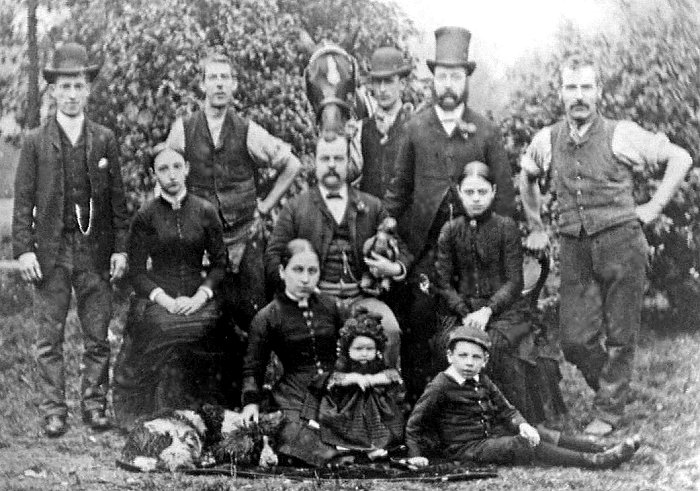
Doctor Tonks and his
household in 1885. Courtesy of David Parsons. |
|
Doctor Tonks worked
tirelessly to improve the health of the
poorer people in the town, where he became
known as ‘The poor man’s doctor’, charging
just six pence per visit. He was a medical
referee for the Prudential Assurance
Company, a member of several societies, as
well as the local Liberal Club, in which he
became Vice President.
It seemed that Joseph
would have a long and happy life, but things
went very wrong on Wednesday, August 29th,
1888, at the Willenhall Horticultural
Society’s annual show in the grounds of the
Central Schools, in Stafford Street. One of
the attractions was a hot air balloon ascent
in the Countess of Dudley balloon, owned by
Captain Morton of Oldbury. The balloon would
be manned by Doctor Tonks, Mr. Joseph Baker,
a local plumber and the pilot, Lieutenant
Lempriere. This was to be Joseph Tonks
second ascent in the same balloon. His first
ascent was when it
was used at the previous show, three years
earlier.
The balloon arrived at
nine o’clock and was quickly inflated. The
weather looked favourable, but at the last
minute it was decided that only two people
should make the ascent instead of three and
so Mr. Baker stepped out of the basket. As
Lieutenant Lempriere called ‘Let go’ a gust
of wind caused the balloon to rise at an
oblique angle. The balloon rose to a height
of about ten feet, followed by a descent of
a couple of feet on to the fence that
surrounded the school ground.
The balloon rapidly got
free and rose to roof height, but collided
with the chimney of Mr. John Perry’s shop at
49 Stafford Street,
causing it to fall down. The balloon then
struck both chimneys in Mr. William Wallern’s house, also causing them to fall
down. The balloon rose yet again and
collided with the chimneys of Mr. Collett’s
house and finally with the chimney of the Haden family’s house, before
being torn apart. The envelope was wrapped
around the chimney, and the basket was left
suspended by its netting, about ten feet in
front of the house.
The onlookers must have
been shocked at what they saw and worried
about the safety of the two men. Haden
family members also had a narrow escape.
Mrs. Haden was in the yard with her three
children watching the ascent. When the
chimney fell, they rushed for shelter in the
house, with Mrs. Haden carrying the youngest
child. Before they entered the house, Mrs.
Haden and the child were knocked over by a
discharge of sand from the balloon and were
only able to get to safety thanks to Mrs.
Haden’s sister, who managed to quickly drag
them into the house. It seems likely that
they would have been badly injured both by
the sand and falling bricks. It was later
discovered that the balloon had been filled
with around ten percent less gas than
normal.
The doctor managed with
difficulty to descend down one of the ropes
to safety, while the lieutenant descended by
means of a ladder. He managed to escape
unhurt, other than being badly shaken and
bruised, but the doctor had received a wound
about 2 inches long and an inch wide in the
fleshy part of the left thigh. He was also
badly bruised on his left knee and left
shoulder.
When Doctor Tonks
reached the ground, he visited the marquee
to assure everyone that he was not too badly
injured and was then taken home by a friend.
It was not realised that although the
injuries would take some time to heal, they
would result in his early and untimely
death.
Initially he seemed to
be on the road to recovery. In 1889 he
passed an examination for the Licentiate of
the Apothecaries Hall, Dublin, which enabled
him to add the letters L.A.H. to his name
and he became Medical Officer for the
Guardians of the Poor and also Public
Vaccinator for the towns of Willenhall and
Short Heath. He also continued with his
heavy workload, but his health began to
deteriorate and was a source of concern to
family and friends. The deterioration
continued, so much so that shortly after
nine o'clock on Thursday, May 2nd, 1891 he
passed away, just three days before his 36th
birthday. At the time, his widow Clara was
just 27 years old with two children to look
after. Doctor Tonks was buried 5 days later
at Wood Street Cemetery, Willenhall. |
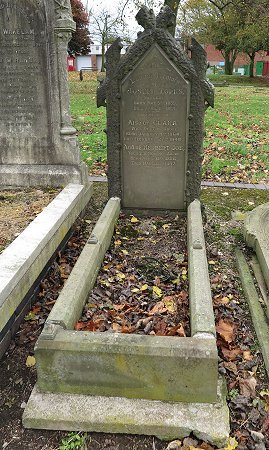 |
|
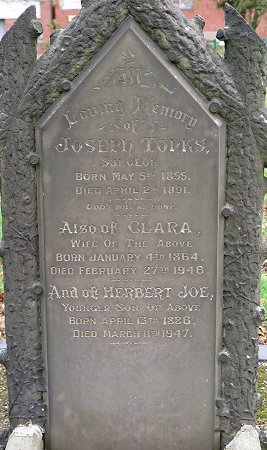 |
|
Doctor Tonks'
family grave in Wood Street Cemetery. |
|
| Clara and her children moved from
their home in Walsall Street to enable
Doctor William Bott M.R.C.S. who had
become Doctor Tonks' assistant, to take
over the practice. He is listed as a
surgeon, medical officer and public
vaccinator for the Wolverhampton Union.
Clara and the children are believed to
have moved to Harper Street, where they
lived for several years before moving to
Clothier Street. In the 1920s, Clara
and her younger son, Herbert Joe, moved
to Wolverhampton, living in Cemetery
Drive, which was between what is now
Aspen Way and Merridale Cemetery. All
that stands there today is a row of
garages. Clara died on February 27th,
1946 at the age of 82 and was buried in
the same grave as her late husband.
Herbert Joe survived her for just over a
year. He died on 11th March, 1947 at the
age of 62 and was also was buried in the
family grave. His younger brother
Reginald Ernest Tonks, died in 1962.
The
Memorial Clock
Many local people
were saddened and shocked at the loss of
their doctor, who in his short lifetime
had done so much to help the residents
of the town. As a result a meeting was
held in the New Inn, Walsall Street, now
called The County. A memorial committee
was formed and the landlord agreed to
make a room available for future
meetings.
The committee
decided to raise money to erect a
drinking fountain in memory of Doctor
Tonks. Mrs. Tonks readily gave her
support to the plan and many generous
donations were quickly received. Money
poured-in and it was realised that
something far grander than a drinking
fountain could be built.
Willenhall
Local Board of Health was contacted to
ask permission for a drinking fountain
to be erected in a prominent place.
Meanwhile a design was drawn-up for a
drinking trough for cattle and dogs,
with four clock faces, by Messrs Boddis,
sculptors and stonemasons of Birmingham.
It was to be built in Hollington and
Bath stone with a clock supplied by
Messrs Smith of Derby, surmounted by an
ornamental frame. The total estimated
cost was £250.
The Local Board of
Health recommended that the memorial
should be built in the Market Place, the
supply of water for the drinking trough
being supplied by Wolverhampton
Corporation. Work on clearing part of
the southern end of the Market Place in
readiness for the building of the
memorial, began in April 1888 and
building work rapidly progressed. It was
decided that the day of the inauguration
of the memorial should be a general
holiday. |
|
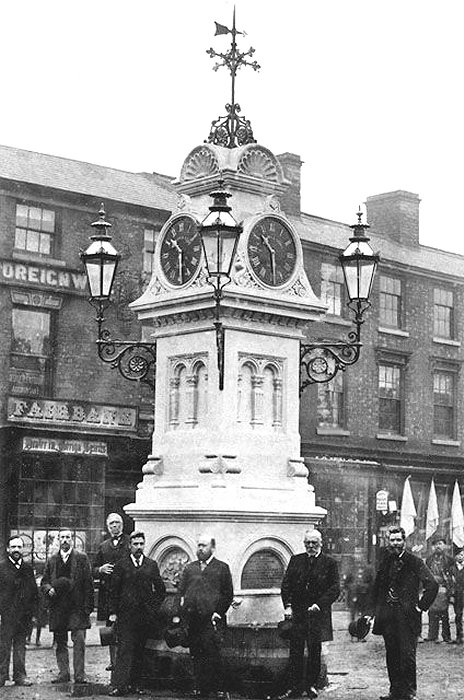
Some of the
dignitaries at the unveiling ceremony. |
The unveiling ceremony
took place at 4 o'clock in the afternoon on
Tuesday 10th May, 1892. It was a bright
sunny day and large crowds gathered in the
Market Place and along the route to be taken
by the procession.
Many shops and
factories closed and a large number of flags
and banners were flown. The long procession
started from Stringes Lane at about 3
o’clock and included members of the local
and school boards and members of local
friendly societies. The procession also
included ‘D Company’ of
the 3rd Volunteer Battalion, South
Staffordshire Regiment, the Fire Brigade and
military prize bands.
A platform had been
erected in the Market Place to accommodate
the Memorial Committee, town dignitaries and
guests. Mr. James Carpenter Tildesley,
ex-Chairman of the Willenhall Local Board of
Health presided at the event.
The memorial was
unveiled by the surgeon Lawson Tait.
Afterwards there was an official banquet
with yet more speeches. The day was a great
success, everything went as planned.
|
|
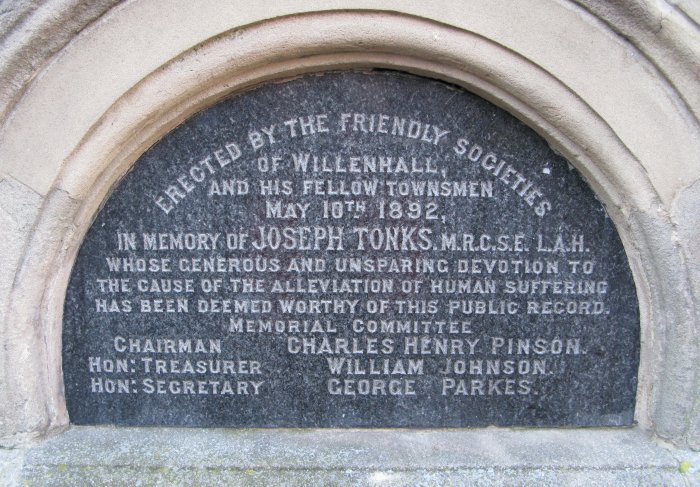
The plaque on the memorial clock. |
|
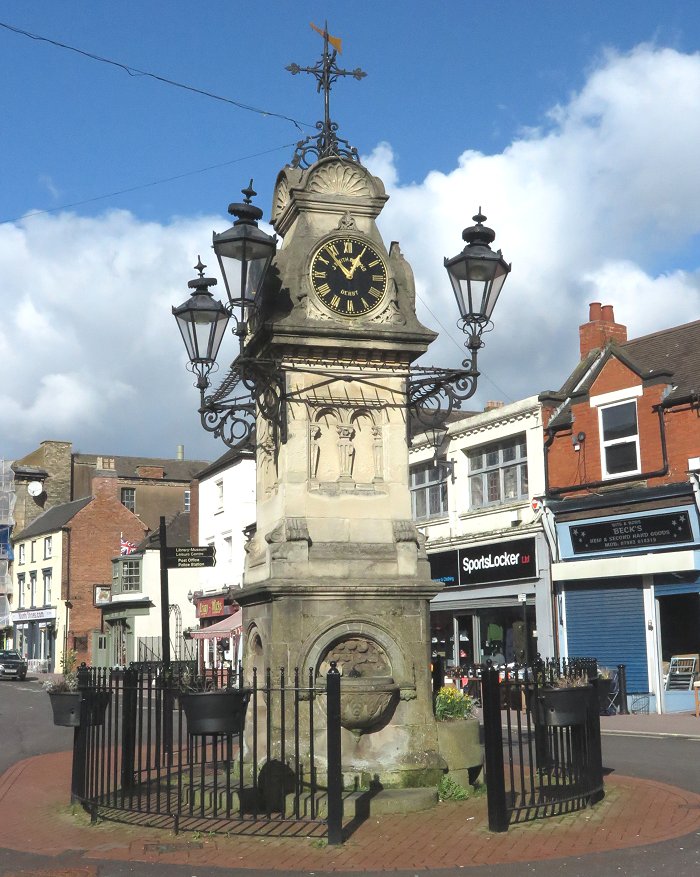
Another view of the
memorial clock. |
|
On the first anniversary of
the unveiling, Wednesday 10th May, 1893, a
dinner was given to celebrate the successful
event. On 31st July, 1986 the memorial was Grade
II listed. It is still one of the best known
structures in the town. |
|

The memorial clock in
the late 1920s. From an old postcard. |
|

A late
1920s view of Walsall Street. |
|

An earlier
view of Walsall Street, looking
towards New Road. |
|

The Midland Bank and
Market Place. |
| By the late 19th century, Willenhall’s
graveyards were rapidly running out of space, and a new cemetery
became a necessity. It was decided to build a cemetery on farm land
in Wolverhampton Road West, Bentley, acquired from the Earl of
Lichfield in 1894.
The new cemetery was designed by the town
surveyor, Mr. B. Baker, who planned the site to include a mortuary
chapel, and a sexton’s lodge. |
|

The cemetery entrance. From an old postcard. |
|
Work started on the site in July 1896, and was
carried out by Mr. Owens of Wolverhampton. During the following
year the site had been prepared, and drainage work undertaken. The
chapel, lodge, and walls were constructed by Mr. Thomas Tildesley,
who began working at the site in July, 1897.
The new cemetery was officially opened by
Thomas Nicholls J. P., Chairman of Willenhall Urban District Council,
on the 16th July, 1900, in front of a crowd of around 2,000
spectators. The final cost of the project was £7,725.12s.0d.
Somewhat more than had been previously expected.
|
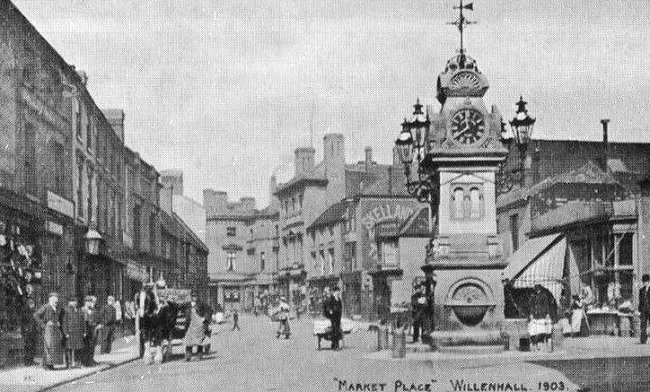
From an old postcard.

From an old postcard.
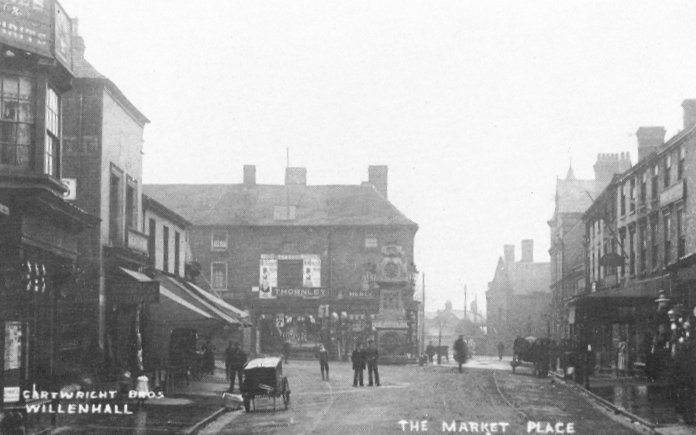
From an old postcard.
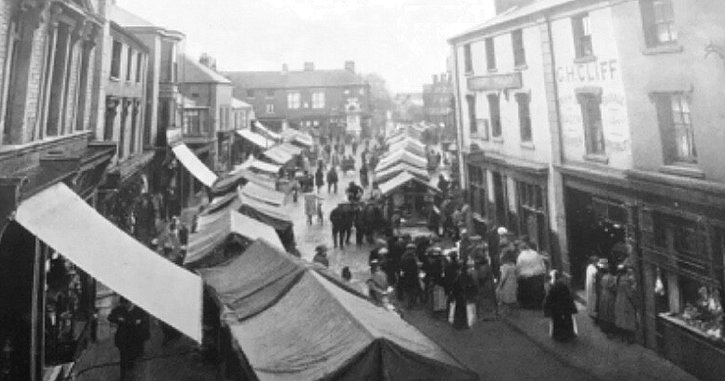
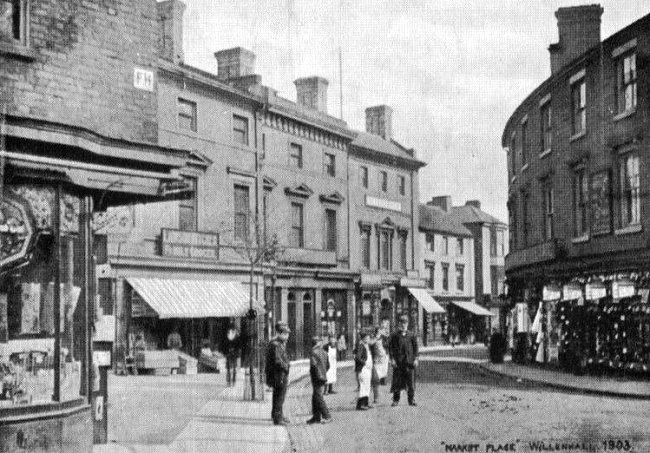
From an old postcard.
|
The Boer War
Many Willenhall men joined the army, and fought
in the Boer War in South Africa between 1899 and 1902. Twenty three
of them lost their lives. They joined the following regiments: the
South Staffordshire Regiment, the Shropshire Light Infantry, the
Worcestershire Regiment, the Imperial Yeomanry, the North
Staffordshire Regiment, and the East Kent Regiment. They are
recorded on two plaques at the back of Willenhall War Memorial.
 |
The bonfire built to celebrate the Coronation of King
George V and Queen Mary, on the 22nd June, 1911.
|
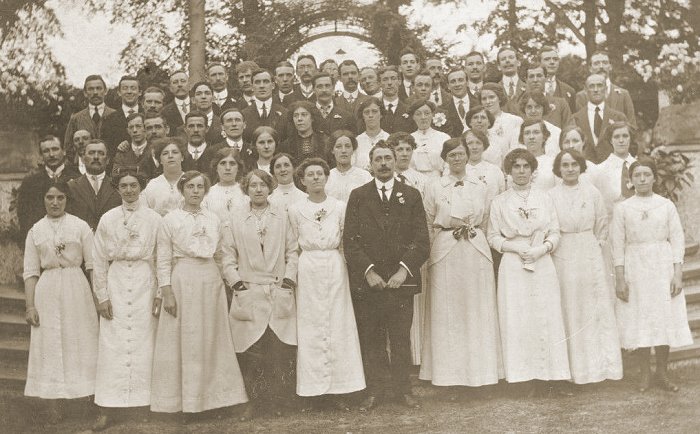
Willenhall Choral Society. From an old
postcard.

Spring Bank Stadium
The stadium, which was built on the north side
of Temple Road, opened on Monday 4th September, 1905 with a match
between Birmingham (now Birmingham City) and the Willenhall Swifts.
It was watched by a large crowd who saw Birmingham win by 3 goals to
1. The ground became the headquarters of the Swifts and continued to
be so until the First World War. The last match before the war
intervened, took place on the 30th October, 1915 between the Swifts
and their local rivals, the Willenhall Pickwicks. After the war the
two teams amalgamated to form Willenhall Football Club, with Spring
Bank Stadium as their headquarters. The new club played its first
game on the 26th April, 1919 at Walsall, with a return match at
Spring Bank the following week. The team played in the Birmingham
and District League and won the league championship in 1922.
By 1930 the number of spectators had
drastically fallen, and the club found itself in financial trouble.
The club went into voluntary liquidation, and Spring Bank Stadium
was sold and converted into a greyhound track. Greyhound racing
continued on the site until 1980 when the owners, Ladbrokes decided
to close the stadium because of falling attendances. It was sold to
Barratts, who demolished the stadium and built around 100 houses on
the site. It is commemorated in the names of a couple of the streets
that were built on the site; Stadium Close, and Circuit Close.
Willenhall’s present football team, Willenhall
Town was formed in 1953 and plays at its site in Noose Lane.
|
|
The First World War
When war was declared on 4th August, 1914 large
numbers of Willenhall men joined the local regiments and soon found
themselves fighting abroad, in France, Belgium, and as far afield as
the Dardanelles.
Many of them lost their lives during the fearsome
fighting in the trenches at the Somme, and at Ypres, Paschendaele,
and the Gallipoli Campaign.
They are remembered thanks to the war memorials
at Portobello and Willenhall. 312 names are recorded on the
Portobello war memorial, and 445 names are recorded on the
Willenhall memorial.
The people of Willenhall are well known for
their generosity. During the war they collected £204,309 for the war
effort.
As the war progressed, local manufacturers received
orders for war work from the Ministry of Munitions, and produced
many items including gun parts, shells, hand grenades, and horse
shoes. |
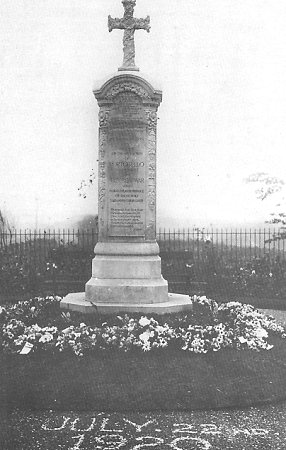
| The
Portobello war memorial. From an old
postcard. |
|

A photo from an old
postcard celebrating the collection of
£204,309 during Willenhall War Weapons Week.
Enough to buy 81 aircraft. |
|

An old postcard
showing some of the celebrations in the
Market Place at the end of the First World
War. |
|
Cinemas
Willenhall's first cinema, the Coliseum, opened
in 1914 in the old Hincks family’s malthouse on the corner of
Bilston Street and New Road. This was soon followed by the opening
of a second cinema, the Picture House, which opened in Stafford
Street on the 19th April, 1915. The Picture House was a
purpose-built cinema with first class facilities, whereas the
Coliseum was housed in a not very suitable building, with inferior
facilities. The Picture House was the more successful of
the two, particularly when ‘the talkies’ arrived.
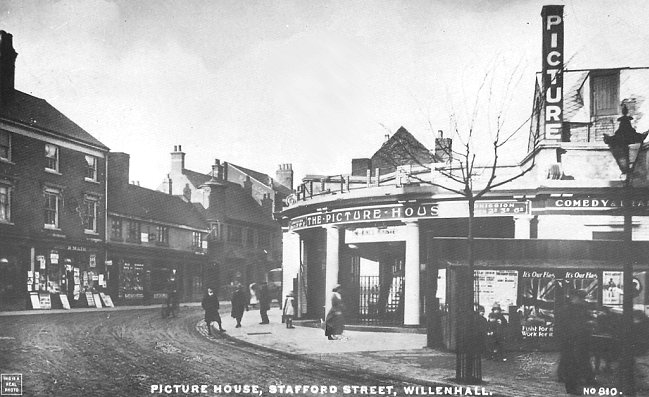
From an old postcard.

Another view of the Picture House. From an old
postcard.
When Mrs Price, the last member of the Hincks
family, died, her estate, including the Coliseum was put up for
sale. It was purchased by John Tyler, a local councillor, builder,
plumber, and decorator, who with his daughter Norah, decided to
replace the cinema with a modern state of the art design.
|
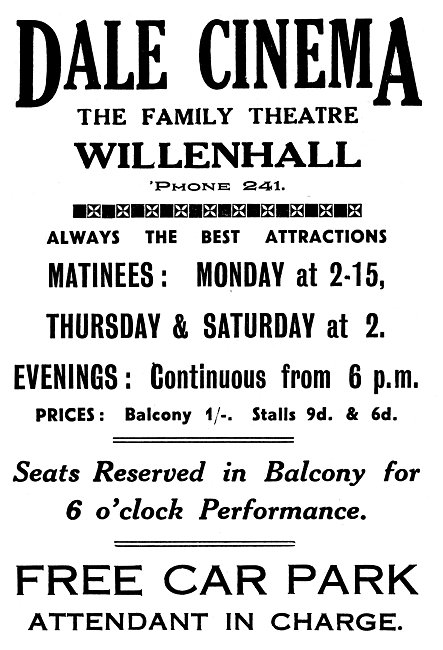
An advert from 1937. |
The building became the Dale Cinema, seating 1,150
people, including 250 on the balcony. It opened on the
31st October, 1932 with a showing of ‘Viennese Nights’,
in Technicolor, with high quality Western Electric
sound. Norah Tyler continued to run the cinema until her
death in 1945 when it was acquired by J. L. and A. H.
Brain who ran a cinema at Aldridge. With the increased popularity of television,
cinema audiences started to dwindle, and Willenhall, like many other
towns eventually lost its cinemas.
The Picture House closed on the
2nd May, 1959 and was demolished in 1961. The Dale continued in
operation until the 30th December, 1967, then reopened as a bingo
hall on the 16th February, 1968.
In the late 1990s it was converted
into a public house, appropriately named ‘The Malthouse’,
a J. D. Wetherspoon’s pub, which opened on the 21st December, 1999.
It began to suffer from a lack of customers and so was
put-up for sale. It finally closed its doors on Sunday
the 26th March, 2023. |
|
|
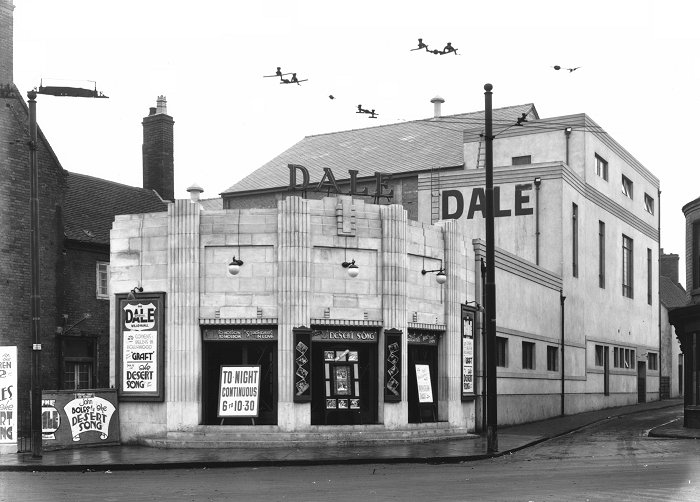
The Dale Cinema in the 1930s.
Courtesy of John Hughes. |
|
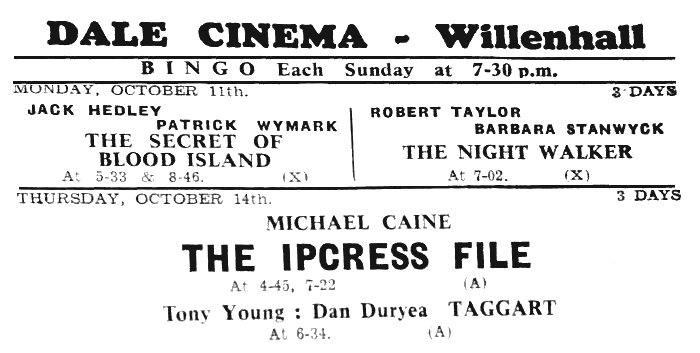
An advert from 1965. |
| |
|
| View the Willenhall entry
in the Midland Counties of England Trades Directory of
1918 |
|
 |
| |
|
|
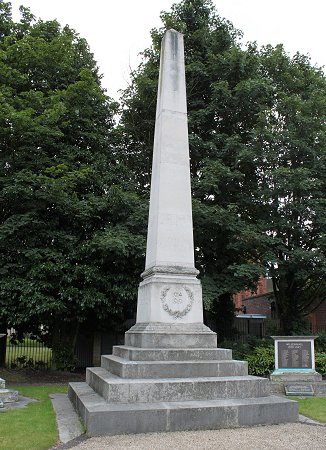
The Willenhall War Memorial. |
Willenhall’s War Memorial on the corner of
Stafford Street and Field Street was officially opened on the 30th
September, 1920 by Lord Dartmouth.
The memorials were dedicated by
the Reverend H. P. Hyatt on the 4th June, 1922.
There are two plaques commemorating those who died in
the First World War, and a large and small plaque
commemorating those who died in the Second World War.
Two other plaques set in the boundary wall
commemorate those who died in the Boer War. In between
them is a small plaque stating that the tablets were
moved to the war memorial in 1964 having been removed
from the gate piers at Wood Street Cemetery. |
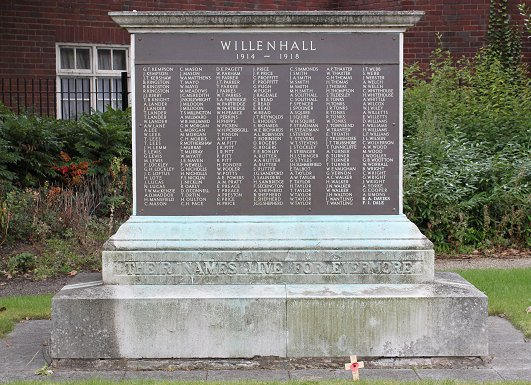
One of two plaques dedicated to those who
died in action in World War One.
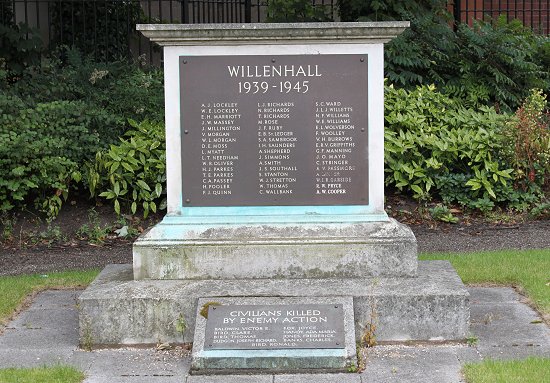
The memorial for those who died in World War
2.
|
Municipal Housing
The local population steadily increased during
the 19th century and the early years of the 20th century, so that
new houses were badly needed to reduce overcrowding, and to improve
living standards amongst the poorer members of society. The
council’s Housing and Town Planning Committee held its first meeting
in November 1918 and considered the possibility of buying land for
new housing.
The 1919 Housing Act gave local
authorities the responsibility to provide suitable
housing for the expanding working class population.
|
| In August 1919 the council purchased land in
Temple Road for the building of 74 council houses, which were to be
the first council houses in the town. Over the next few decades, thousands of council
houses were built throughout the town, and much of the open land
disappeared.
The houses were built in many areas including Spring
Bank, Wolverhampton Road, the southern side of the Memorial Park,
and the area to the east of Rose Hill. |

From an old postcard. |

Willenhall Football Club. Date unknown.
Courtesy of Tony Highfield.
|
In 1931 Willenhall lost its passenger train
services at Stafford Street railway station when the LMS withdrew
passenger services on the old Midland line. The railway remained
open for goods until the 1st November, 1965.

An advert from 1937.
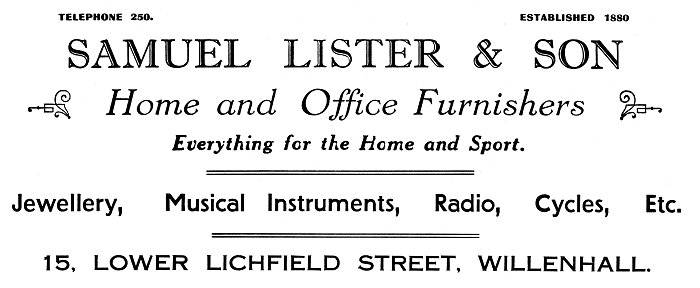
An advert from 1937.
|
World War 2
Although fewer lives were lost during the
Second World War, its impact was just as great as the previous
conflict. In September 1940 the council launched an appeal called
‘The Willenhall Fighter Aircraft Fund’. It raised £6,750 to pay for
a Spitfire aircraft which was presented to the government on behalf
of the local people, and named ‘Willenhall’.
A few weeks later
Willenhall directly experienced the might of the German Luftwaffe
during the town’s first air raid. On the 20th November, houses were
destroyed in Ward Street, Ann Street, and Springvale Street, and St.
Anne’s Church was slightly damaged. 12 people were killed, and many
were injured, or left homeless. The homeless were initially cared
for by the Salvation Army at the Citadel in Moat Street.
Those killed were: Clara Bird, Ronald K. Bird,
Thomas Bird, Joyce Fox, Frederick Jones, Lily Jones, Mary Jones,
William Moreton Jones, Joseph Lockley, Geoffrey Morris, George
Morris, and Owen Morris.
There was a second air raid on 31st July, 1942,
this time on the Wolverhampton to Walsall Road. It seems that German
aircraft were following the railway line, and dropped bombs en
route. Four people were killed, and several houses and part of a
factory were destroyed.
Those killed were Beatrice Farrington in
Peel Street, Ada Maria Handy in New Road, Joseph Richard Dudgon in
Wolverhampton Road, and Charles Henry Banks, also in
Wolverhampton Road. The civilian dead from the air raids were buried in a special
part of Bentley Cemetery. |
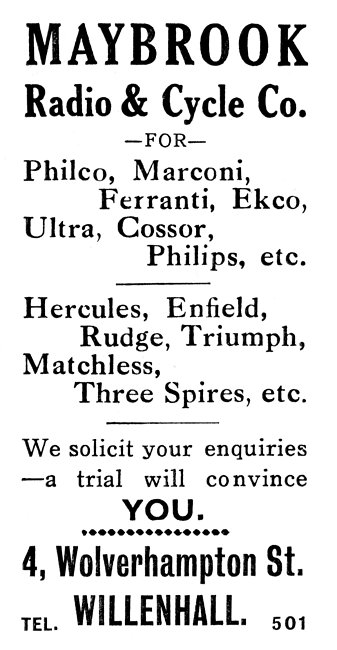
An advert from 1937. |
|
|

An advert from 1926. |
During both air raids the enemy aircraft were
fired on by the anti-aircraft guns that were set up on an area of
land between Ashmore Lake and Broad Lane South, known as the Five
Fields. There were several large guns, searchlights, and radar which
were manned by members of the Anti Aircraft Regiment. The site was
totally unsuitable, being heavily waterlogged in the winter months,
and so the battery only stayed for part of the war.
During the air raids, help was provided by the
100 or so volunteers in the Willenhall section of the Women’s
Voluntary Service, and the town’s Civil Defence Services. The
Willenhall Fire Service also helped out in the aftermath of air
raids at Birmingham, Coventry, Liverpool, London, Manchester, and
Plymouth.
Willenhall war memorial contains a plaque
listing 93 names of members of the armed forces who were killed by
enemy action during the war. Although the number is far less than in
World War One, it still had a huge impact on the town.
|
|
The Post War Years
After the war, Willenhall continued as a busy,
successful industrial town, much like its neighbours.
In May 1948, the houses in St. Ann's Square, which stood
on the southern side of Ann Street, at the eastern end,
past St. Anne's Church, were declared to be unfit for
habitation and a demolition order was served on them.
They were home for 50 to 60 people who then had to find
alternative accommodation. The site was acquired by H.
G. Smith, Steel Fabrications.
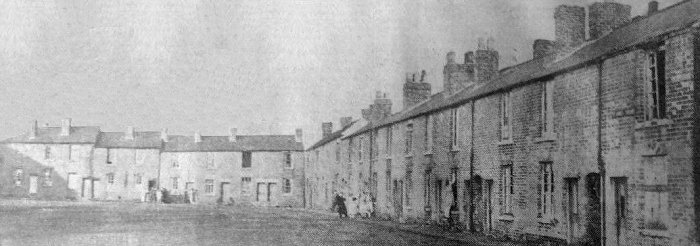
St. Ann's Square. From an old
newspaper cutting. |
|
|
View the Willenhall
listing from
a 1961-62 Trades Directory |
 |
| |
|
|
In January
1965 the town lost Bilston Street railway station when the line was
closed to passenger traffic.
An even more important event happened
the following year as a result of the Local Government Reform Act.
Despite much local opposition, Willenhall lost its status as an
urban district, and like neighbouring Darlaston, and Bentley, came
under the direct control of Walsall Metropolitan Borough.
|
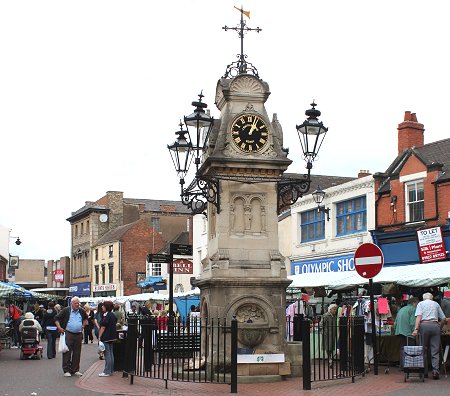
The Market Place. |
| By the late 1970s, Willenhall, and the other
Black Country towns were beginning to feel the effects of industrial
decline. Job losses were reported almost daily in the media, and
many once successful businesses closed. The factories started to
disappear, and many of the larger factories such as John Harpers,
Josiah Parkes, and even Yale’s Wood Street factory, have now gone,
something that was unimaginable only a few decades ago. Lock
manufacturing in Willenhall has almost disappeared, only a
handful of skilled lockmakers now remain in business. Luckily the industry is still remembered in the
form of the Locksmith’s House, in New Road. It opened in April 1987
as The Lock Museum, and has displays featuring locally made locks,
one of the few remaining lock workshops, and an early 20th century
lock maker’s home. The museum suffered from insufficient funding and
closed in 2002, but luckily the Black Country Living Museum took the
site over, and after a lot of investment, reopened it in 2003 as The
Locksmith’s House. It is the country’s only dedicated lock museum. |

Tom Millington and David Plant demonstrating
at The Lock Museum.
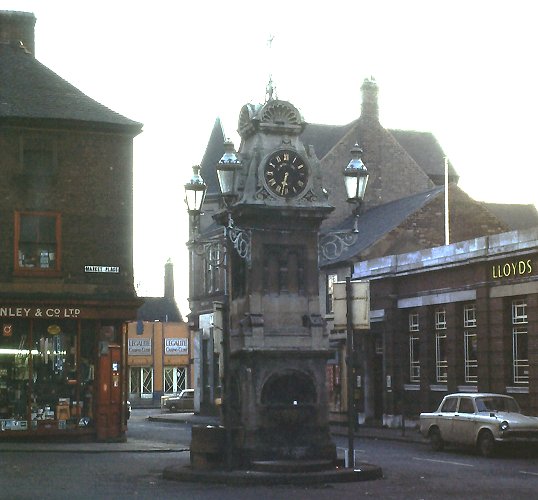
An evening view of the memorial
clock in the Market Place. Taken by Richard Ashmore in
the mid 1970s. |
|
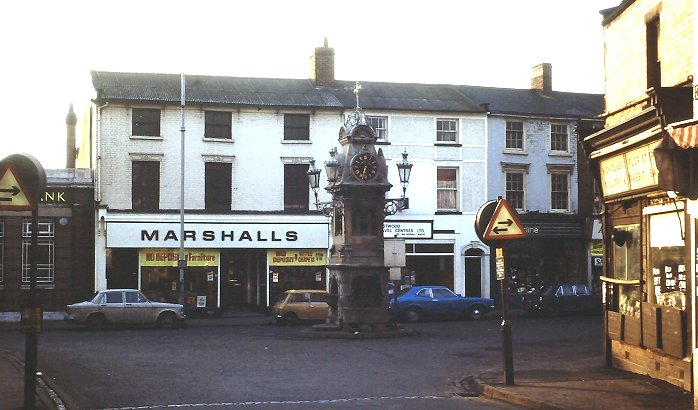
Another view of the memorial
clock, taken by Richard Ashmore in the mid 1970s. |

The old Post Office in
Wolverhampton Street, now a chemist. Taken by Richard
Ashmore in the mid 1970s. |
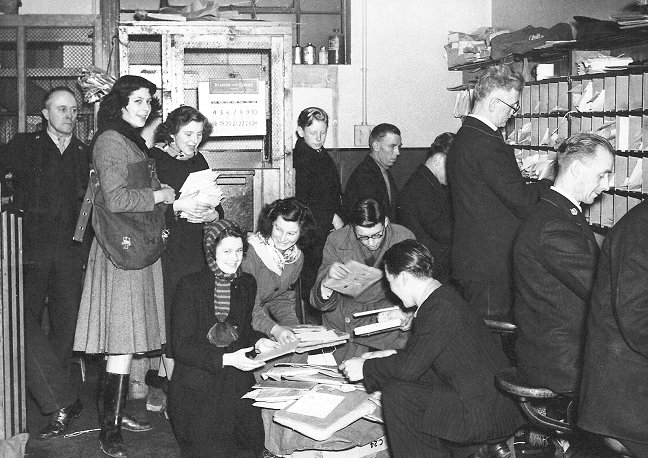
Sorting the Christmas mail at the
post office. Richard Ashmore who took the previous three
photographs is on the far right looking down. |
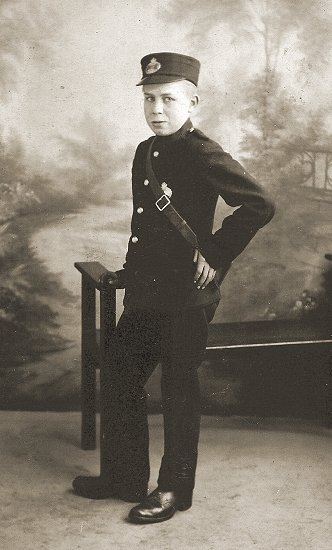 |
A Willenhall messenger boy,
from an old postcard.
Courtesy of Christine and John Ashmore. |
|
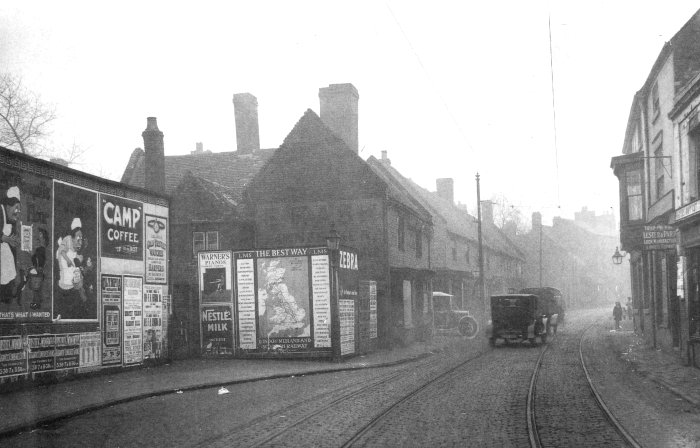
Walsall Street in the 1920s. |
|

A view of St. Giles' Church from
Walsall Street, taken by Richard Ashmore in the mid
1970s. |
|
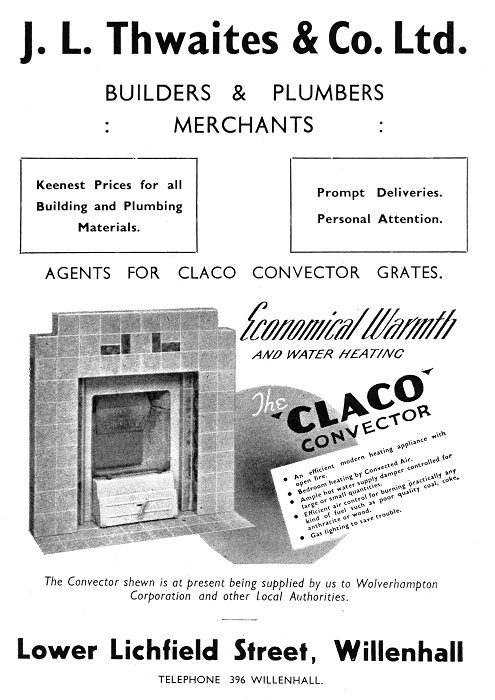
An advert from 1948. |
The largest development in the town centre took
place in 2009 with the demolition of Yale’s Wood Street factory, and
the building of the new Morrisons store, which opened in January
2010.
Although many changes have taken place over the
last few years, Willenhall is still regarded as one of the most
intact towns in the Black Country, still retaining much of its
original atmosphere.
Many little workshops and factories remain
around the town, giving a flavour of the once successful
manufacturing centre.
Many of the lovely Georgian and Victorian
buildings still survive, and the vibrant Market Place has kept much
of its character.
|
|
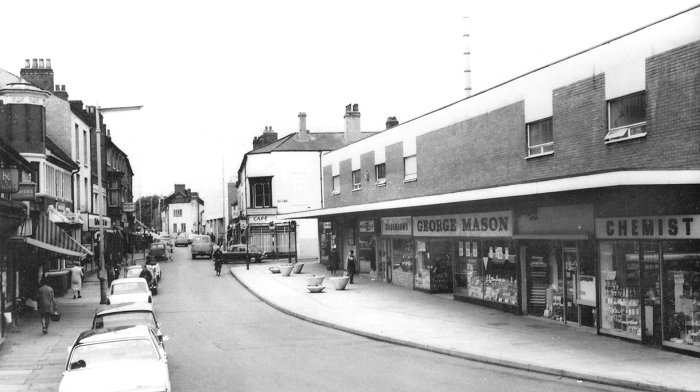
Stafford Street in the 1970s. From
an old postcard. |
|
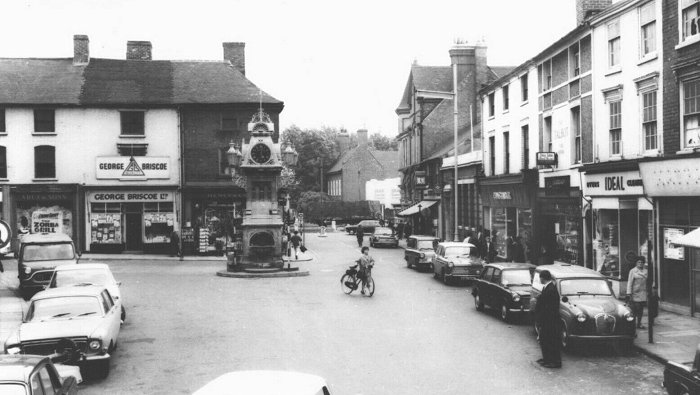
The Market Place in the
1970s. From an old postcard. |
|
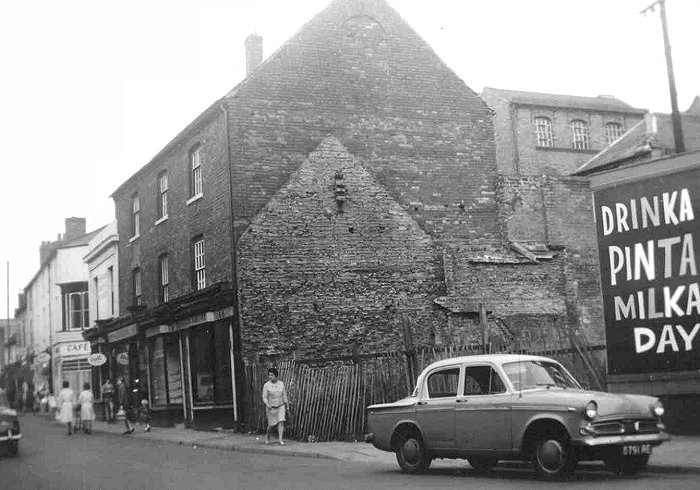
An earlier view of Stafford
Street before the modern shops were built. |
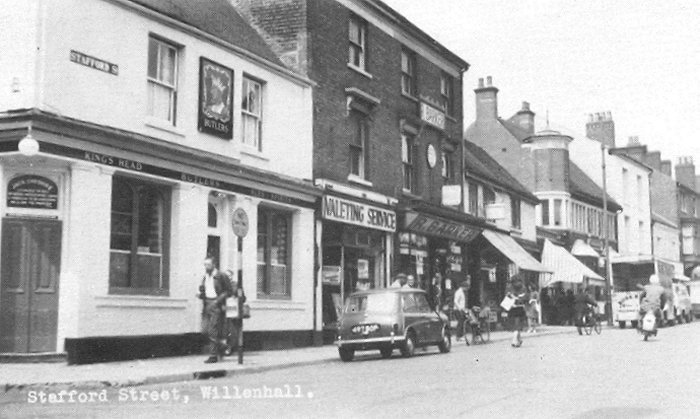
From an old postcard.
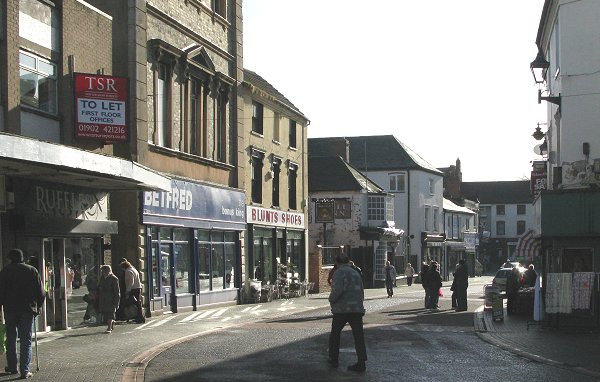
Some of the lovely old buildings that are to
be found in the Market Place.
| Much of the town centre is now designated as a
conservation area, and so its character and charm will survive. Many
Willenhall people are fiercely independent, and although the
town is now part of Walsall, it still retains its own identity, and
hopefully will continue to do so, and continue to prosper, for years
to come.
The Town Crier, Cyril
Richardson, in 2010. The 81 year old began his career as
a town crier in the early 1990s, and has been doing it
in Walsall since the mid 1990s. |
 |

| On a sad note,
part of the old Legge factory shown above,
was severely damaged at the end of February
2011 after a mindless arson attack. |
|
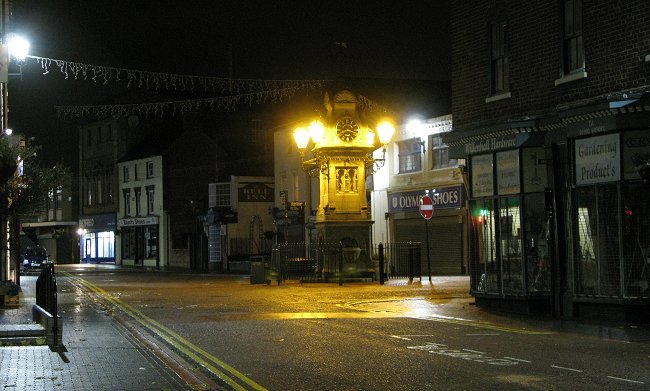
The Market Place at night. November 2013.
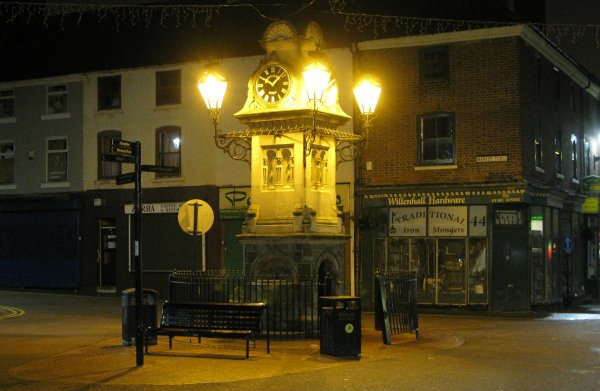 |
Another night time view of the
Market Place. |
| The market in April 2014. |
 |
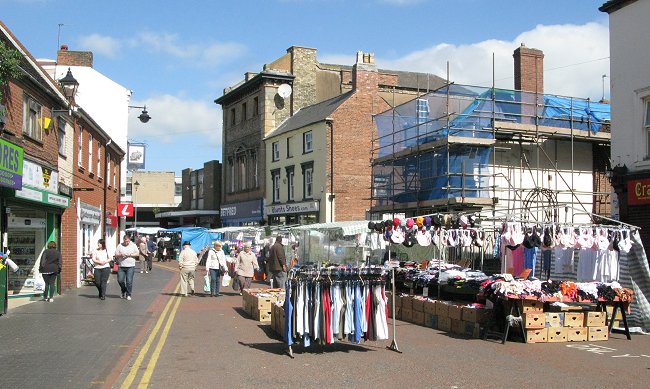
Another view of Willenhall market in April
2014.
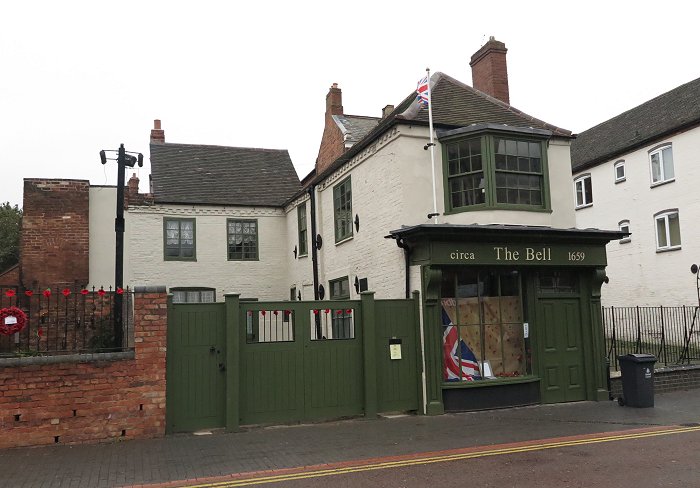
The Bell in 2015.

| The Old Toll House at 40 Walsall Street was
wonderful restaurant offering a first class service. It
became extremely popular and could cope with 120 diners
at a time. Unfortunately things started to go wrong
during Covid and the business never really recovered. It
began to loose money and so it finally closed on the
24th February 2025. This was a great loss because
restaurants of this quality are few and far between in
Willenhall. |
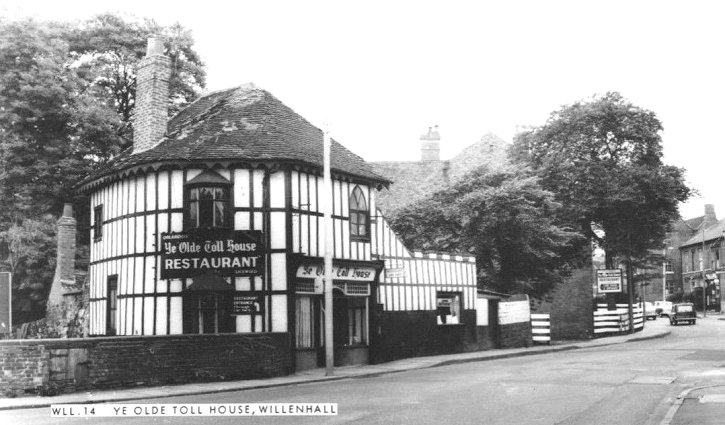
From an old postcard.

Willenhall's well known memorial clock
 |
|
 |
|
 |
Return to
Pubs |
|
Return to
the contents |
|
Proceed to
References |
|